Isaac Schultz
Thu, November 9, 2023
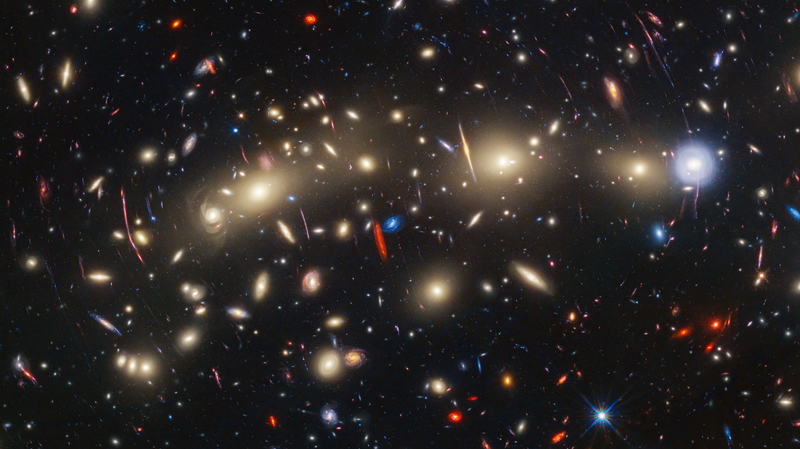
A swathe of the recently imaged galaxy clusters.
It’s not yet December, but NASA is already in a festive mood: the Webb and Hubble space telescopes recently imaged MACS0416, a pair of colliding galaxy clusters 4.3 billion light-years from Earth that is bedecked in sparkling lights.
The image combines visible and infrared light, the respective wheelhouses of Hubble and Webb, to create a sweeping view of the colliding clusters. The Webb observations were taken as part of the Prime Extragalactic Areas for Reionization and Lensing Science, or PEARLS, program, and the Hubble data was collected as part of the Frontier Fields program, which began in 2014.
Two papers detail aspects of the image. One, published in Astronomy and Astrophysics, describes the “extremely magnified monster star” nicknamed Mothra, after the fictional monster that features prominently in the Godzilla franchise. The other paper is accepted for publication in The Astrophysical Journal and is currently hosted on the preprint server arXiv; that work details 14 transient objects seen in the galaxy cluster. These transients are objects that vary in their observed brightness over time, causing the smattering of colors to twinkle in the eye of a telescope.
“We’re calling MACS0416 the Christmas Tree Galaxy Cluster, both because it’s so colorful and because of these flickering lights we find within it. We can see transients everywhere,” said Haojing Yan, an astrophysicist at the University of Missouri in Columbia and lead author of one of the papers, in the same release.
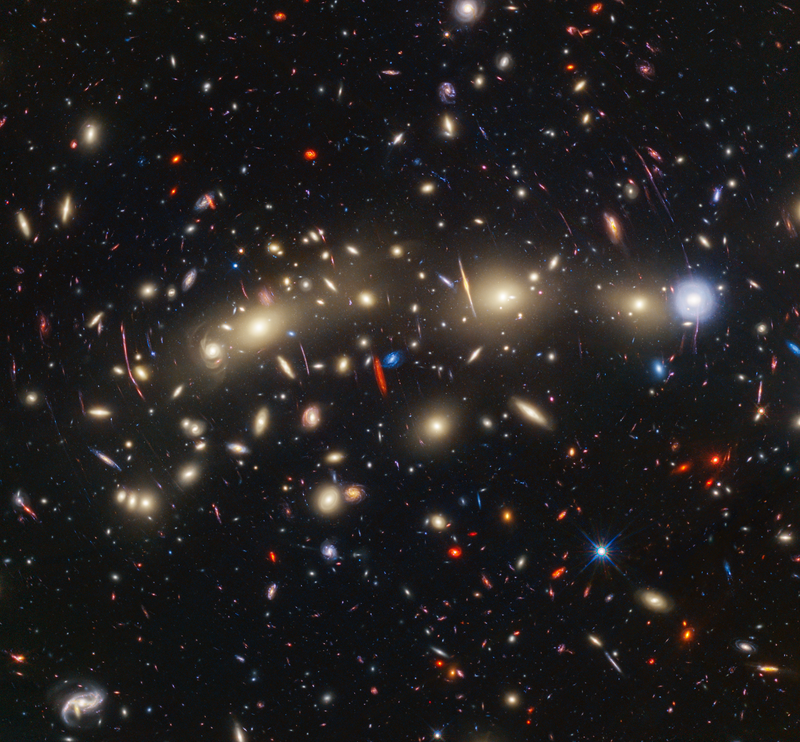
The full image of the galaxies, complete with smears of gravitational lensing.
Twelve of the transients spotted are too faint and red for Hubble to see, so the Webb data was critical in getting a more complete image of the field. The researchers believe the other two transients are supernovae—vast explosions that occur at the end of a star’s life.
The star nicknamed Mothra is located in a galaxy that existed about three billion years after the Big Bang. The research team believes that the monster star is probably in a binary system with another supergiant star, which the team has fittingly nicknamed Godzilla. Mothra is anywhere between 10,000 and one million times our Sun’s mass, and may hint at the nature of dark matter.
In their paper, the team stated that axionic dark matter models (which focus on axions, a theoretical particle named for a detergent) are consistent with their observations in certain mass ranges for the axion. Earlier this year, another case of extreme gravitational lensing boosted the case for axionic dark matter.
As Webb and Hubble continues their investigation of the cosmos, our understanding of dark matter, the universe’s evolution, and the myriad objects that compose the cosmos will come into sharper relief. Their data—as well as the observations of other telescopes, like the nascent Euclid Space Telescope—will help us understand the makeup of the cosmos.
Gizmodo
Cosmic ‘Christmas tree’ dazzles in new image captured by Hubble and Webb
Cosmic ‘Christmas tree’ dazzles in new image captured by Hubble and Webb
Ashley Strickland, CNN
Thu, November 9, 2023
A panorama of colliding galaxy clusters glimmers in a new image, captured by the combined forces of the two most powerful space observatories ever created.
The cosmic phenomenon, called MACS0416, is 4.3 billion light-years from Earth. Eventually, the merging pair of giant clusters will combine to form an even more massive collection of glittering galaxies.
New details of the celestial feature have emerged in the colorful image, which unites the observational powers of Hubble Space Telescope in visible light and the James Webb Space Telescope in infrared light, which is invisible to the human eye.
Together, the renowned observatories present a more comprehensive look at the universe. Hubble has long been used to search for faint, distant galaxies across different wavelengths of light. Webb’s infrared gaze enables that search to occur at even farther distances, detecting invisible light deeper into the early days of the universe.
A light-year, equivalent to 5.88 trillion miles, is how far a beam of light travels in a year. Given the distance between Earth and the objects from the early days of the universe, when telescopes such as Webb observe this light, it’s effectively like looking into the past.
“We are building on Hubble’s legacy by pushing to greater distances and fainter objects,” said Rogier Windhorst, regents professor in Arizona State University’s School of Earth and Space Exploration, in a statement.
Windhorst is the principal investigator of the PEARLS, or Prime Extragalactic Areas for Reionization and Lensing Science, program that conducted the Webb observations.
A ‘Christmas tree’ of galaxies
The colors in the new image, released Thursday, are used to indicate distance. Blue-hued galaxies are the closest, bursting with star formation and easily seen in visible light by Hubble. The red galaxies are more distant, best detected by Webb in infrared light.
“The whole picture doesn’t become clear until you combine Webb data with Hubble data,” Windhorst said.
The new Webb observations were used to search for objects that change in brightness over time, called transients.
Within the galactic clusters’ field of view, Webb helped astronomers identify 14 transients, all of which were visible due to gravitational lensing. This cosmic effect occurs when closer objects — such as the galactic clusters — act like a magnifying glass for distant objects. Gravity essentially warps and amplifies the light of distant galaxies in the background of whatever is doing the magnifying, enabling observations of otherwise invisible celestial features.
The transients include 12 stars or star systems and two supernovas in galaxies that were amplified using gravitational lensing.
“We’re calling MACS0416 the Christmas Tree Galaxy Cluster, both because it’s so colorful and because of these flickering lights we find within it. We can see transients everywhere,” said Haojing Yan, associate professor of physics and astronomy at the University of Missouri. Yan is lead author of one study describing the findings that has been accepted for publication in The Astrophysical Journal.
Spotting a stellar giant
One transient in particular captured the attention of astronomers, a star system they have nicknamed “Mothra,” the titular giant monster of a 1961 Japanese film. The stellar system, magnified by a factor of 4,000 due to gravitational lensing, was traced to a galaxy that existed 3 billion years after the big bang created the universe.
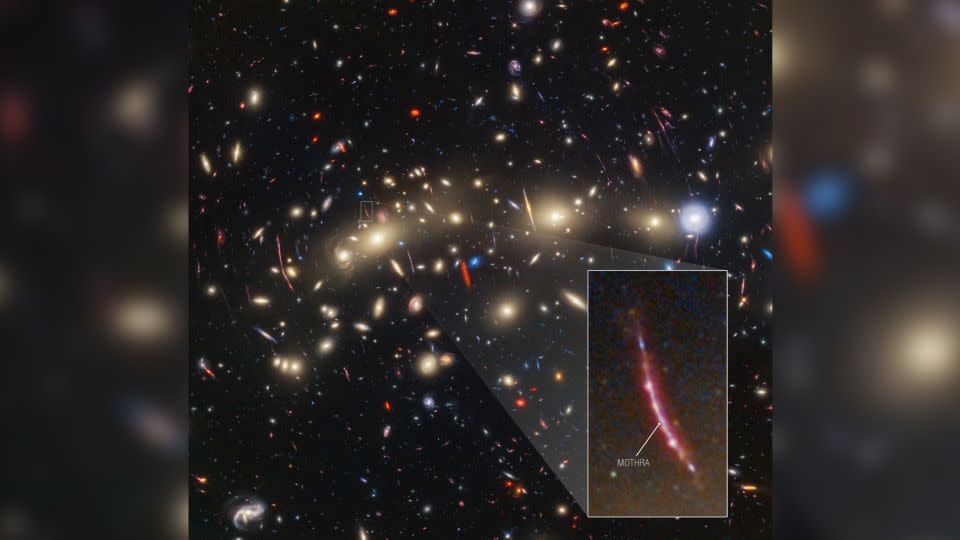
The Webb and Hubble composite image includes "Mothra," a star system magnified by the galactic cluster pair as well as another unseen object. - NASA/ESA/CSA/STScI
The team nicknamed the star system Mothra due to its extreme magnification and brightness.
Surprisingly, Mothra has appeared before, detected in Hubble observations nine years ago. Astronomers are stumped as to how this happened, because there must be a specific alignment between the galactic cluster and the more distant star to cause the magnification at a point in time. So how did Mothra also appear magnified in the new Webb observations?
“The most likely explanation is a globular star cluster that’s too faint for Webb to see directly,” said José Diego, researcher at the Institute of Physics of Cantabria in Spain and lead author of another paper describing the finding, published in the journal Astronomy & Astrophysics. “But we don’t know the true nature of this additional lens yet.”
James Webb Space Telescope gets ready for the holidays with a cosmic Christmas Tree
Robert Lea
Thu, November 9, 2023
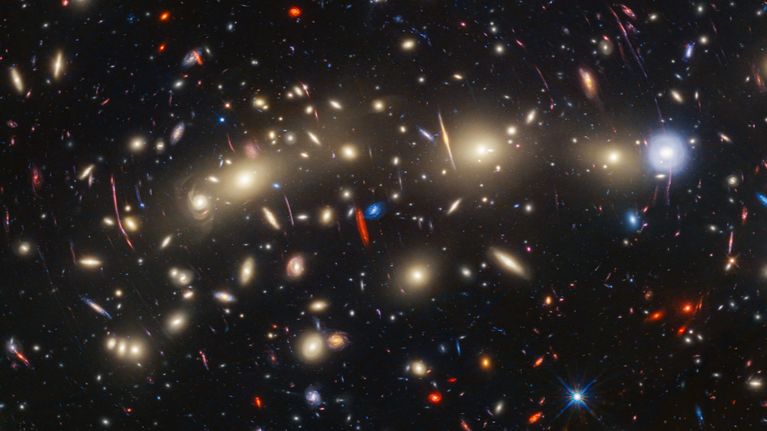
A smattering of galaxies seen as countless dots of light.
The James Webb Space Telescope (JWST) left astronomers feeling festive recently as it allowed them to image a distant, colorful cluster of galaxies they have dubbed the "Christmas Tree Galaxy Cluster."
In this cluster, the James Webb Space Telescope discovered flickering "Christmas lights" in the form of 14 new transient objects — celestial objects that brighten dramatically before dating . The winter wonderland is officially called MACS041, and is located about 4.3 billion light-years from Earth.
"We're calling MACS0416 the Christmas Tree Galaxy Cluster, both because it's so colorful and because of the flickering lights we find within it," Haojing Yan, an associate professor in the University of Missouri Department of Physics and Astronomy, said in a statement. "Transients are objects in space, like individual stars, that appear to suddenly brighten by orders of magnitudes and then fade away. These transient objects appear bright for only a short period of time and then are gone; it’s like we’re peering through a shifting magnifying glass."
Related: James Webb Space Telescope reveals most distant Milky Way galaxy doppelganger
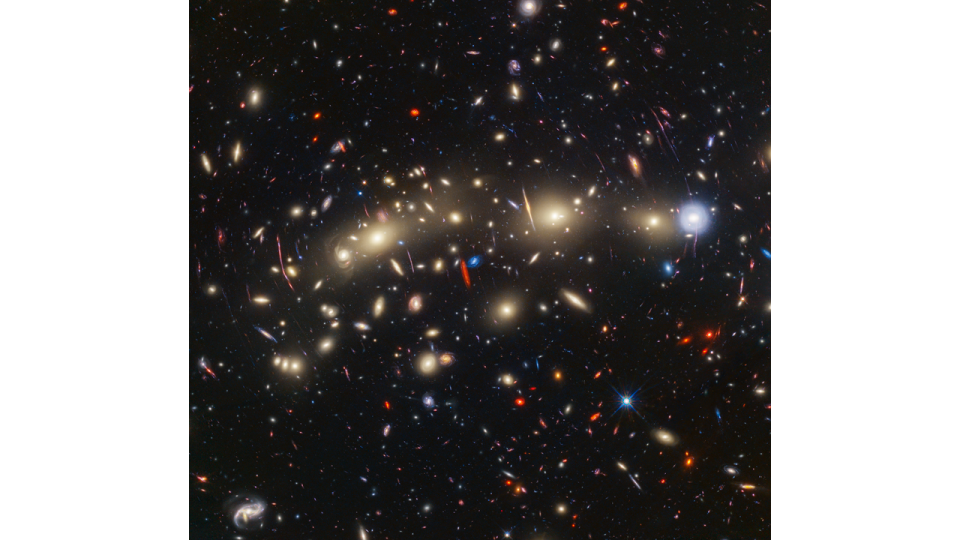
a smattering of galaxies seen as countless dots of light
Spotting so many transients in this galaxy was achieved by teaming the JWST up with the Hubble Space Telescope; the sheer number of transients spotted in one go, thanks to the duo, implies there are a lot more yet to be found within the Christmas Tree Galaxy Cluster. It's almost like the Christmas gift for astronomers that'll keep on giving.
Putting up the Christmas tree with Einstein
The light from the Christmas Tree Galaxy Cluster began its journey across the cosmos when the solar system, now 4.6 billion years old, was newly formed and just around 300 million years old. This would ordinarily make it too faint for even the JWST to see in detail, but a little trick first acknowledged by Albert Einstein made observing this cosmic Christmas a little easier.
In his 1915 theory of general relativity, which concerns the nature of gravity, Einstein said objects of great mass must warp the very fabric of space and time, united as a single entity called space-time, giving rise to a curvature we experience as gravity. And when anything — including light — passes these curved regions of space, those things' paths get curved. The closer to the body of mass a thing is, the more extreme the curvature it experiences.
As a result, when an object passes between Earth and a distant light source, the light from that background object takes a varied amount of time to reach us, as its path isn't following a straight line due to the curvature created by the passing object. This can ultimately cause that background object to appear amplified from our vantage point. The concept is called "gravitational lensing" as the intervening object acts as a natural, cosmic magnifying glass.
The JWST has been tapping into this phenomenon, with great success, to see some of the universe's earliest galaxies — and its view of the Christmas Tree Galaxy Cluster is its latest example.
"We can see so many transients in certain regions of this area because of a phenomenon known as gravitational lensing, which is magnifying galaxies behind this cluster," Yan said. "Right now, we have this rare chance that nature has given us to get a detailed view of individual stars that are located very far away. While we are currently only able to see the brightest ones, if we do this long enough — and frequently enough — we will be able to determine how many bright stars there are and how massive they are."
A monster in the Christmas tree?
The transients were found by Yan and the team as they were looking at four sets of images captured by the JWST over around four months, as part of the JWST’s PEARLS GTO 1176 program. The team has identified two objects in the images as supernova explosions that happen as stars reach the end of their lifespans. Yan is thrilled by this result, as he and his team can now use those supernovas to study the galaxies in which they are happening.
"The two supernovas and the other twelve extremely magnified stars are of different nature, but they are all important," Yan explained. "We have traced the change in brightness over time through their light curves, and by examining in detail how the light changes over time, we’ll eventually be able to know what kind of stars they are."
The astronomers also found something else extraordinary in the Christmas Tree Galaxy Cluster: A monster star in a galaxy, seen as it was when the universe was just 3 billion years old. They have named the star "Mothra" after the monstrous moth, Kaiju, from Japanese cinema.
The galaxy in which Mothra lurks was lensed to around 4,000 times its original brightness. The object lensing this galaxy is currently unknown, but Yan and the team estimate it has a mass of between 10,000 and 1 million times that of the sun. "The most likely explanation is a globular star cluster that’s too faint for the JWST to see directly," Jose Diego, research lead author and a scientist at the Instituto de Física de Cantabria scientist, said in a separate statement. "But we don’t know the true nature of this additional lens yet."
What is extra interesting about Mothra's galaxy is the fact it was also visible and lensed in Hubble Space Telescope images taken nine years ago. Normally, a lensing object and a background galaxy would move out of alignment over such a period, but Mothra's home galaxy and the object lensing it seem to have stuck together. In the future, Yan and the team hope to both figure out the nature of this lensing object and uncover some of its characteristics.
"We'll be able to understand the detailed structure of the magnifying glass and how it relates to dark matter distribution," Yan concluded. "This is a completely new view of the universe that’s been opened by JWST."
One of two papers detailing the observation of the Christmas Tree Galaxy Cluster was published in November in the journal Astronomy and Astrophysics, while the other has been accepted for publication in the Astrophysical Journal with a preprint available on the research repository arXiv.

The Hubble Space Telescope has found evidence of a "wandering" black hole about 5000 light years away in the Milky Way galaxy. Astronomers estimate that there could be 100 million black holes wandering around our galaxy. Credit: NASA Goddard Space Flight
NASA's James Webb telescope spotted the most distant galaxy in the universe that looks like ours
Marianne Guenot
Fri, November 10, 2023
The James Webb Space Telescope spotted a twin of the Milky Way in the depths of the universe.
The galaxy formed shortly after the Big Bang, which was thought to be impossible.
This could mean there's a missing ingredient in our models of how the universe formed.
The James Webb Space Telescope (JWST) has spotted the most distant example of a galaxy in the universe that looks similar to the Milky Way.
The galaxy, named ceers-2112, is more than 11.7 billion years old and is the earliest example of a barred spiral galaxy ever seen.
Astronomers were surprised to see it because cosmic models suggest barred spiral galaxies only started emerging around 6.9 billion years after the Big Bang.
The latest discovery, published in the journal Nature, could upheave our models of the universe and how dark matter influenced galaxy formation in its early days, study authors said.
A barred spiral galaxy exists in the universe's infancy
With its advanced imaging capabilities, JWST has allowed us to peer into the early universe with more precision than ever before.
The latest study is no exception. To a layperson, the picture below may look like little more than a colorful blob — and when looking at information coming from the early days of the universe, that's the kind of image that we're usually working with.

Three near-infrared pictures of ceers-2112 provided by JWST imaging are shown here. This image was cropped from the original.Costantin, L., Pérez-González, P.G., Guo, Y. et al. A Milky Way-like barred spiral galaxy at a redshift of 3. Nature (2023). https://doi.org/10.1038/s41586-023-06636-x. CC-BY 4.0
But with JWST's precise measurement instruments, scientists were able to squeeze out crucial information about ceers-2112's characteristics. For them, there is little doubt: this picture suggests this is a barred spiral galaxy.
But this galaxy is in redshift 3, a technical term suggesting it appeared about 2 billion years after the birth of the universe
That's a conundrum, as a barred spiral galaxy is a very tall order for such a young universe.
Previous models had suggested such complex galaxies would take at least a few billion years to evolve. Scientists had thought you couldn't find a barred spiral galaxy before the universe was about 6.9 billion years old.
"The discovery of ceers-2112 shows that it can happen in only a fraction of that time, in about one billion years or less," Alexander de la Vega, a physicist and cosmologist at the University of California, Riverside, said in a press release accompanying the findings.
"It is the first publication that finds in the childhood of the universe these spiral galaxies that have a disk with a central bar," Yetli Rosas Guevara, an astrophysicist of the Spanish Donostia International Physics Center who was not involved in the study, told El País.
The findings could shed light on the early days of dark matter
The new finding suggests something is wrong with models predicting what was happening in the early days of the universe.
"In the past, when the universe was very young, galaxies were unstable and chaotic. It was thought that bars could not form or last long in galaxies in the early universe," de la Vega said.
Simulations "really struggle to reproduce such systems at those epochs," Luca Costantin, study lead author and astrophysicist at the Centro de Astrobiología in Madrid, told Space.com.
"We now need to understand which key physical ingredient is missing in our models — if something is missing," Costantin told Space.com.
One factor that doesn't quite align is the role of dark matter in the early days of galaxy formation.
As a reminder, the stuff that makes up everyone on Earth, our planet, our galaxy, and everything we can observe, is ordinary matter, or baryon. But physicists think baryon makes up only 5% of our universe. The other 95% — about 27% of dark matter and 68% of dark energy — remain huge mysteries in physics.
Some models suggest there was an "over-abundance" of dark matter in the early days of the universe, study co-author Jairo Abreu, a researcher at the University of La Laguna, told Space.com.
But that doesn't quite make sense with the latest findings: barred spiral galaxies are more likely to be made up of baryon, said Abreu.
This suggests that "these models may need to adjust how much dark matter makes up galaxies in the early universe, as dark matter is believed to affect the rate at which bars form," said de la Vega.
No comments:
Post a Comment